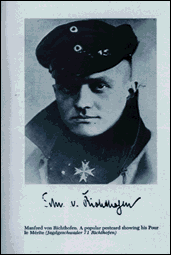"It is in the blood of every German to rush to meet the enemy." When speaking about Oswold Boelck..."He shot one or two Englishmen for breakfast every day." "Success flourishes only in perseverance -- ceaseless, restless perseverance.""When one has shot down one's first, second or third opponent, then one begins to find out how the trick is done." "If I should come out of this war alive, I will have more luck than brains." "I hope he roasted all the way down." Edward Mannock, on hearing of the death of Manfred von Richthofen
|
The
war's highest scoring ace (80 credited kills); the reserved Prussian aristocrat dazzled
all Germany with his exploits, even the British RFC toasted his prowess. A cool and precise hunter, Richthofen's flamboyance was expressed mainly in his brightly painted aircraft, a Fokker DR-I Dridecker . He was nicknamed The Red Baron. Commander of Jadgstaffel 11, and later the combined squadrons Jadggeschwader 1, Richthofen was killed in action on April 21, 1918. He was survived by his brother Lothar, also a noted ace. Manfred von Richthofen was born on May 2, 1892 at Breslau, Prussia (now Samotwor, Poland). He died on April 21, 1918 in the skies over Vaux sur Somme, France. He was 25 years old. He was called der rote Kampfflieger by his own people, le petit rouge by the French, and the Red Baron by the English. In a time of wooden and fabric aircraft, when twenty air victories insured a pilot legendary status and the coveted Pour Le Merite, Richthofen had eighty victories, and is regarded to this day as the ace of aces. Manfred von Richthofen was born the son of Major
Albrecht von Richthofen, a Prussian nobleman and his wife, Kunigunde. He was the eldest of
three sons (the eldest child was his sister, Ilse). He was enrolled at age 11 at the
military school at Wahlstatt, and then attended the Royal Military Academy at
Lichterfelde. He was a far better athlete than he was a scholar, and applied his horseback
riding skills to become a cavalry officer. He was commissined in April, 1911 in the 1st
Regiment of Uhlans Kaiser Alexander III. He was promoted to Leutnant in 1912. On April 21, 1918, Richthofen followed the
Sopwith Camel of Wilfred May far into British territory. The end of the war was only
months off by this time, and the Germain air command faced both ever-improving British
airplanes and their own dwindling numbers. The thrill of the hunt was all but gone for
Baron von Richthofen, as most of his peers had already been killed and his own wounds
agonized him. Though the German air doctrine he himself wrote stated that "one should
never obstinately stay with an opponent which, through bad shooting or skillful turning,
he has been unable to shoot down while the battle lasts until it is far on the other
side", he chased his British quarry far deeper into enemy territory and far lower to
the ground than his own doctrine permitted. |
